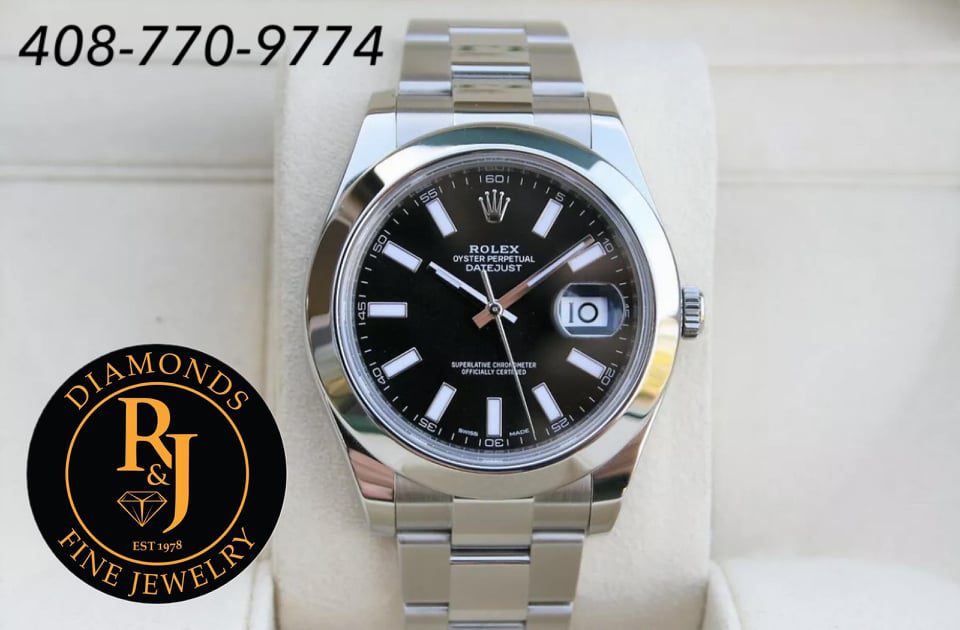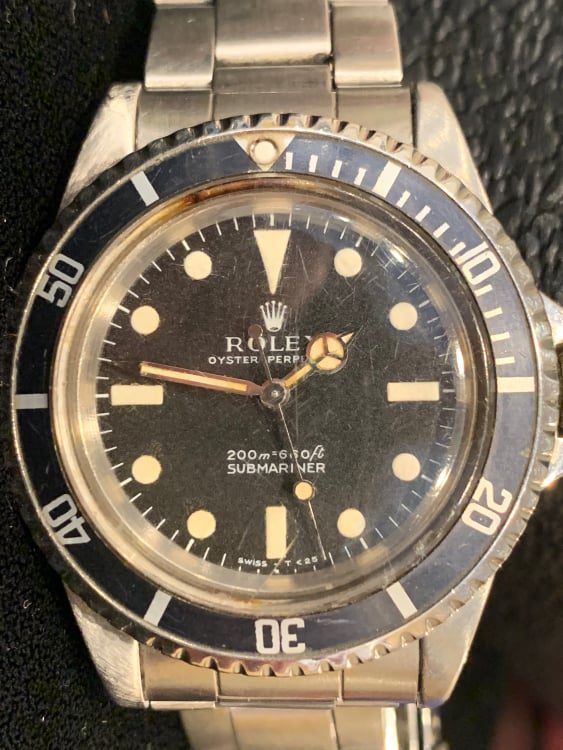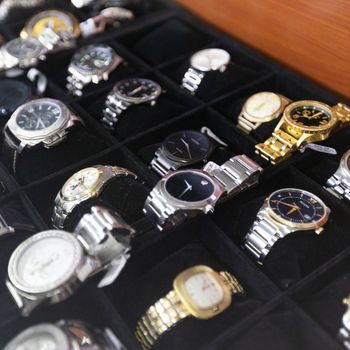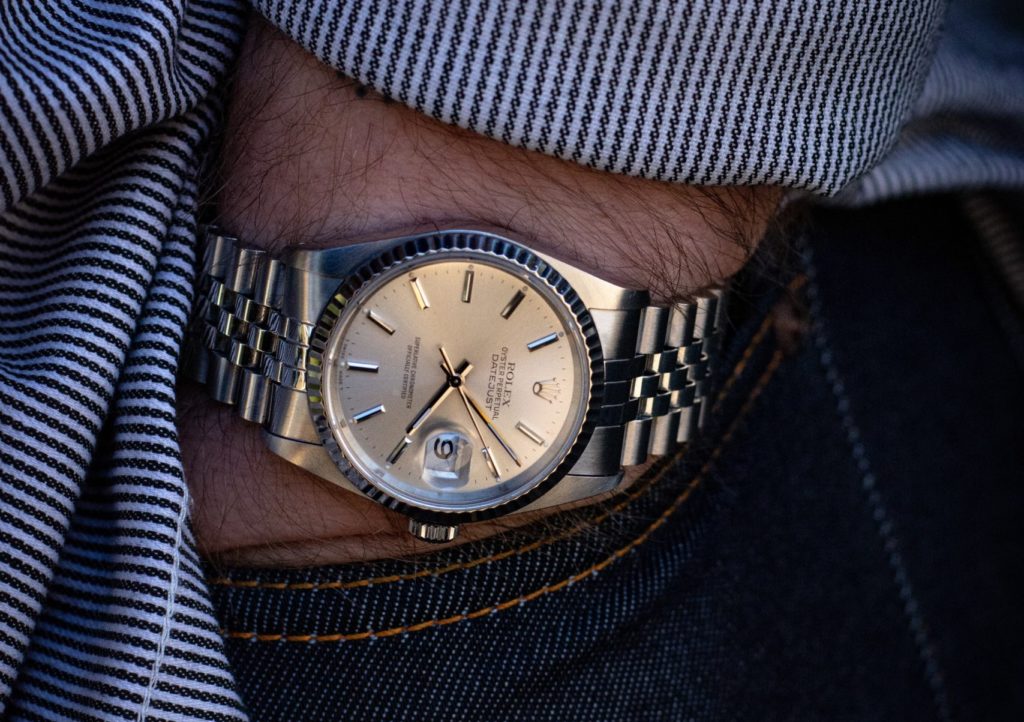Curious about what sets Rolex watches apart? In this article, we’ll explore unique Rolex features such as the Oyster case, Perpetual movement, and Cyclops lens. Learn how these innovations contribute to Rolex’s legendary status.
Key Takeaways
The Rolex Oyster case, first introduced in 1926, revolutionized watchmaking by providing a hermetically sealed design for enhanced durability and reliability.
Rolex’s Perpetual movement, patented in 1931, ensures continuous self-winding through wrist motion, maintaining precision without manual winding.
The Superlative Chronometer certification guarantees that Rolex watches exceed traditional accuracy standards, reinforcing the brand’s commitment to precision and quality.
A Brief History and Development of Rolex
Rolex stands as a beacon of luxury watches, with a rich history that stretches back over a century. Founded in 1905 by Hans Wilsdorf and Alfred Davis, the brand began its journey in London, initially focusing on importing Swiss movements and assembling them into high-quality timepieces. In 1908, Hans Wilsdorf registered the name “Rolex,” a name that would soon become synonymous with precision, durability, and timeless elegance.
From its earliest days, Rolex set out to redefine what a luxury watch could be. The brand’s relentless pursuit of innovation led to the creation of the world’s first waterproof wristwatch, the Oyster, in 1926—a milestone that forever changed the landscape of watchmaking. Over the decades, Rolex introduced a series of groundbreaking models, including the legendary Daytona, the robust Submariner, and the versatile GMT-Master, each earning its place in the world of luxury timepieces.
Rolex’s commitment to quality and innovation has made its watches highly sought after by collectors and enthusiasts worldwide. Today, the brand continues to set the standard for excellence, blending advanced technology with timeless design. Whether you’re drawn to the rich history of the brand or the enduring appeal of its iconic models, Rolex remains a symbol of prestige, craftsmanship, and luxury.
The Rolex Oyster Case: A Milestone in Watchmaking

The Rolex Oyster case, introduced in 1926, marked a revolutionary milestone in the world of watchmaking. This innovative case design was the first to be hermetically sealed, protecting the watch’s movement from water and dust. It symbolized a new era of durability and reliability, setting Rolex apart from other luxury watches.
The hermetically sealed construction of the Oyster case ensures that the watch remains impervious to external elements, safeguarding its intricate movement. This design has become a defining characteristic of Rolex watches, contributing to their reputation for exceptional build quality and engineering. The robust nature of the Oyster case not only enhances the watch’s longevity but also reinforces its status as a luxury timepiece.
Today, the Oyster case remains a cornerstone of Rolex’s identity, reflecting the brand’s dedication to creating watches that merge timeless elegance with exceptional durability. Whether you’re investing in a new or pre-owned Rolex, the Oyster case is a testament to the brand’s unwavering dedication to excellence. The Oyster case has become a hallmark of the brand’s watches, symbolizing their prestige, craftsmanship, and enduring appeal.
Perpetual Movement: The Heartbeat of Rolex Watches
One of the key features that distinguish a genuine Rolex watch is its perpetual self-winding movement. Patented in 1931, the Perpetual rotor allows the watch to be continuously wound through the natural motion of the wearer’s wrist. This innovative mechanism ensures that Rolex watches maintain precision and reliability without the need for manual winding.
The Perpetual rotor system includes:
The Perpetual rotor combined with reversing wheels, which transmits energy to the mainspring regardless of the rotor’s movement direction, ensuring consistent power supply.
The Chronergy escapement, which optimizes energy transmission for superior timekeeping accuracy.
Microstella nuts, allowing for precise adjustments to the movement’s oscillation speed, a feature unique to Rolex.
Rolex’s perpetual movement is a testament to the brand’s commitment to precision engineering and innovation. It is the heartbeat of Rolex watches, ensuring that they keep time with unparalleled accuracy and reliability. Understanding this feature is crucial for appreciating the craftsmanship in a pre-owned Rolex.
The Cyclops Lens: Enhancing Readability
A distinctive feature of Rolex watches is the Cyclops lens, introduced in 1953. This small yet impactful innovation magnifies the date display by 2.5 times, significantly improving its readability. The Cyclops lens quickly became synonymous with Rolex, enhancing the practicality of their timepieces. Discover the elegance and precision that define these iconic watches.
The lens is seamlessly integrated into the sapphire crystal during manufacturing, ensuring perfect alignment with the date window. This meticulous attention to detail exemplifies Rolex’s commitment to both functionality and aesthetics.
The Cyclops lens is a significant attribute for anyone desiring a luxury watch with timeless design and practical features.
Unique Rolex Dials: A Palette of Luxury
Rolex dials are a canvas of luxury, showcasing a variety of rare and exquisite materials. One of the standout features is the use of Gibeon meteorites, renowned for their unique crystalline patterns and limited availability. These meteorite dials are not only striking but also add a touch of cosmic wonder to the watch.
Malachite, with its rich green hue and distinctive banding, is another material used in Rolex dials. The natural beauty of malachite makes each dial unique, appealing to collectors and enthusiasts alike. Mother-of-pearl is also frequently used, displaying an array of natural colors and patterns that enhance the watch’s elegance.
Rolex also incorporates precious materials such as diamonds, platinum, and rose gold into select dials. The use of high-quality, certified diamonds, luxurious platinum, and exclusive rose gold further enhances the luxury and exclusivity of these timepieces.
Rolex uses the following materials to create dials that are both beautiful and unique:
Sodalite: characterized by its royal blue color and unique veining, used in some specific models, adding to their rarity and value.
Bloodstone: known for its deep green color with red speckles.
Marble: despite its delicate nature, it is employed to create unique dials.
The variety of materials used in Rolex dials highlights the brand’s dedication to craftsmanship and luxury. Each dial is a work of art, reflecting the timeless elegance that Rolex is known for. The unique dials, whether in vintage or new models, exemplify Rolex’s commitment to quality and design.
Rolesor: The Art of Combining Gold and Steel

Rolesor, the unique combination of gold and steel, exemplifies Rolex’s ability to blend elegance with strength. Trademarked by Rolex in 1933, Rolesor has been a signature design element in their watches since the 1930s, showcasing its rich history. This technique combines the lustrous qualities of gold with the robust nature of stainless steel, creating a timepiece that is both visually striking and durable.
There are three variations of Rolesor:
Yellow Rolesor: stainless steel and yellow gold
Everose Rolesor: stainless steel and Everose gold
White Rolesor: stainless steel with a white gold bezel
Each variation offers a distinct aesthetic, catering to different styles and preferences for collectors alike. The combination of metals not only enhances the watch’s appearance but also reinforces its durability, creating a stunning collection.
Rolesor watches are a perfect example of Rolex’s craftsmanship, blending precious metals with advanced engineering to create a luxury timepiece that stands the test of time. Rolesor models offer a blend of timeless elegance and robust performance, making them a great choice for those considering a pre-owned Rolex.
Cerachrom Bezel: Unmatched Durability and Color
The Cerachrom bezel, introduced by Rolex, is crafted from a high-tech ceramic that is nearly impervious to scratches and offers vibrant colors that resist fading. This innovation ensures that the bezel maintains its pristine appearance over time, even under the harshest conditions.
The unique chemical composition of the Cerachrom bezel makes it non-corrosive, maintaining its integrity and color over time. Rolex’s proprietary methods for producing ceramic components ensure consistent quality and color, making the Cerachrom bezel a hallmark of durability and elegance.
The Cerachrom bezel guarantee both beauty and longevity, making it a key feature for anyone seeking a genuine Rolex watch.
Parachrom Hairspring: Superior Precision and Shock Resistance
Rolex’s Parachrom hairspring has the following features:
Made from a unique alloy of niobium and zirconium
Resistant to magnetic fields and temperature fluctuations
Ensures superior precision and reliability in various conditions
Has a distinctive blue color resulting from a thickened oxide layer, which enhances its stability
The Parachrom hairspring is designed to be up to ten times more shock-resistant than traditional hairsprings, ensuring that the watch maintains accuracy even under impact. This innovation is a result of five years of development, showcasing Rolex’s commitment to precision engineering and advanced technology.
Rolex movements also utilize a Paraflex shock absorber, further protecting the watch from impacts and maintaining accuracy. The Parachrom hairspring represents the pinnacle of precision and durability, appealing to those who appreciate the finer things in life.
Triplock Crown Seal System: Ultimate Water Resistance
The Triplock crown seal system is a testament to Rolex’s dedication to creating watches that can withstand extreme conditions. Introduced to enhance the waterproof capabilities of Rolex watches designed for diving, the Triplock system includes an additional seal, providing ultimate water resistance. This makes it ideal for professional divers and underwater explorers.
Rolex watches with the Triplock system are rigorously tested to ensure they exceed their rated depths. The three sealed zones of the Triplock crown effectively prevent water intrusion, ensuring durability and reliability even under extreme underwater pressure.
The Triplock crown seal system is a crucial feature for anyone seeking a durable luxury watch.
Chromalight Display: Enhanced Legibility in Low Light
Rolex introduced the Chromalight display in 2008, providing enhanced legibility in low light conditions. Key features of the Chromalight display include:
Emits a blue glow that remains visible for up to eight hours, significantly longer than many other luminescent materials
Applied to the hands and hour markers of nearly all modern Rolex sports watches
Ensures visibility in dark conditions
The proprietary Chromalight is manufactured using a precise process that creates luminescent crystals, ensuring consistent luminosity. The Chromalight display enhances the overall experience of wearing a Rolex, appealing to those who value both functionality and aesthetics.
Superlative Chronometer Certification: A Mark of Excellence

Rolex’s Superlative Chronometer certification is a mark of excellence, indicating that a watch exceeds traditional chronometer standards. This certification ensures accuracy between -2 and +2 seconds per day after casing, reflecting Rolex’s commitment to precision. Since 1951, Rolex has certified nearly all watches leaving their production facility, adopting the term ‘superlative’ to signify enhanced precision.
Rolex performs extensive internal testing alongside official COSC certification to verify each watch’s performance in:
-
Precision
-
Power reserve
-
Waterproofness
-
Self-winding capabilities
These tests simulate real-world conditions, ensuring that Rolex watches perform reliably over time.
The Superlative Chronometer certification is a vital factor for anyone seeking a highly sought luxury timepiece, such as the gmt master ii, with the highest quality materials and prestige quality standards.
Certified pre-owned Rolex watches often come with a two year international guarantee, providing buyers with added assurance of authenticity and reliable coverage worldwide.
Iconic Rolex Models and Collections
Rolex has crafted some of the most iconic watch models and collections, captivating collectors alike and setting benchmarks in the world of luxury. The Submariner, introduced in 1953, is celebrated as the ultimate diving watch, renowned for its robust construction and classic style. The Daytona, launched in 1963, quickly became a favorite among racing enthusiasts, thanks to its precision chronograph movement and association with speed and performance.
The GMT-Master, first released in 1954, revolutionized travel watches with its innovative dual-time zone function, making it a top choice for globetrotters and collectors. The Datejust, with its instantly recognizable date window and timeless design, remains a staple in the Rolex collection, while the Day-Date, often referred to as the “President’s watch,” is synonymous with prestige and leadership.
Other notable collections, such as the Oyster Perpetual, showcase the brand’s dedication to versatility and enduring style. Each model and collection reflects Rolex’s unwavering commitment to luxury, quality, and innovation, making them highly sought after by collectors and enthusiasts around the world.
Caring for Your Rolex: Maintenance and Longevity
Owning a Rolex watch is an investment in both craftsmanship and heritage, and proper care is essential to preserve its value and performance. Regular maintenance is key—this includes periodic cleaning, lubrication, and adjustment of the movement to ensure your timepiece runs smoothly. It’s also important to inspect the case, bracelet, and dial for any signs of wear or damage.
To maintain the integrity of your Rolex watch, avoid exposing it to extreme temperatures, strong magnetic fields, or harsh chemicals, as these can affect the movement and appearance. Always use genuine Rolex parts and accessories when servicing your watch, as this helps retain its authenticity and value. For the best results, have your timepiece serviced by an authorized Rolex dealer or a skilled watchmaker familiar with the brand’s standards.
By following these guidelines, you can ensure that your Rolex remains a cherished timepiece, ready to be enjoyed for generations to come.
The Rolex Community: Education, Passion, and Connection
The world of Rolex is more than just luxury watches—it’s a vibrant community united by a shared passion for timeless elegance and rich history. Collectors, enthusiasts, and connoisseurs from around the globe connect through online forums, social media groups, and exclusive events, creating a dynamic network where knowledge and appreciation for Rolex watches flourish.
Within this community, members exchange insights about new models, rare collections, and the finer points of horology. Whether you’re showcasing a prized vintage piece or learning about the latest innovations, the Rolex community offers a welcoming space for education and discovery. It’s a place where the love for luxury timepieces and the brand’s storied legacy brings people together, fostering connections that span generations and continents.
For anyone drawn to the world of Rolex, joining this community is an opportunity to deepen your understanding, share your passion, and celebrate the enduring allure of the brand’s watches and collections.
R&J Jewelry and Loan: Your Trusted Place for Pre-Owned Rolex Watches
When it comes to finding authentic pre-owned Rolex watches, R&J Jewelry and Loan in San Jose stands out as a trusted destination. Specializing in both vintage and contemporary models, R&J offers a curated selection of luxury watches for discerning buyers and collectors. Their expertise ensures that every pre owned Rolex watch is thoroughly inspected for quality and authenticity, giving you confidence in your purchase.
Whether you’re searching for a specific model, looking to sell your timepiece, or simply exploring the world of pre owned Rolex, R&J Jewelry and Loan provides a seamless and professional experience. Their commitment to customer satisfaction, combined with a deep understanding of the value and heritage of Rolex watches, makes them a top choice for anyone interested in luxury timepieces.
With a reputation built on trust, quality, and value, R&J Jewelry and Loan is your go-to source for pre owned Rolex watches in San Jose and beyond. Discover the perfect addition to your collection or give new life to a cherished watch with the help of their knowledgeable team.
R&J Jewelry and Loan Your Trusted Place for Pre-Owned Rolex Watches
R&J Jewelry and Loan in San Jose, CA, is a trusted source for pre-owned watches and pre-owned Rolex watches. Specializing in purchase and loaning against luxury watches, R&J offers a secure and straightforward process for obtaining short-term loans using fine watches as collateral. Their expertise in appraising and valuing fine watches ensures customers receive fair offers. R&J Jewelry and Loan pays competitive prices for used Rolex and other luxury watches.
The shop provides a wide range of authentic Rolex models, making it a notable destination for those seeking to buy, sell, or pawn pre-owned luxury watches. R&J Jewelry and Loan offers competitive price, including premium prices, making luxury timepieces more accessible to collectors and enthusiasts. The cost of pre-owned and used Rolex watches can vary depending on factors such as model, rarity, and condition, and R&J Jewelry and Loan provides transparent pricing. For those in the resale market, R&J Jewelry and Loan is a reliable and trustworthy option for second hand Rolex, used Rolex, as well as brand’s watches. As official Rolex jewelers, they ensure the authenticity of every timepiece. All repairs and servicing are performed using genuine parts to maintain the value and authenticity of each watch.
Summary
In summary, Rolex watches are a testament to the brand’s commitment to innovation, precision, and luxury. From the groundbreaking Oyster case to the advanced Chromalight display, each feature reflects Rolex’s dedication to excellence. The brand’s unique features and limited production contribute to the high demand for Rolex watches among collectors worldwide. Understanding these unique features is essential for appreciating the value and craftsmanship of pre-owned Rolex watches.
For enthusiasts and collectors alike, investing in a Rolex is more than just acquiring a timepiece; it’s owning a piece of horological history. Vintage Rolex watches, in particular, hold special appeal and investment potential, as they are highly sought after due to their rarity and collectible value. Whether you’re exploring the resale market or seeking a new addition to your collection, the timeless elegance of Rolex watches continues to captivate and inspire.
Frequently Asked Questions
What makes the Rolex Oyster case unique?
The Rolex Oyster case is unique due to its hermetically sealed design, which safeguards the watch’s movement from water and dust, embodying exceptional durability and reliability.
How does the Perpetual movement work in Rolex watches?
The Perpetual movement in Rolex watches utilizes a patented rotor that winds the watch as the wearer moves their wrist, ensuring it remains powered continuously and maintains precision. This innovative mechanism highlights Rolex’s commitment to reliability and performance.
What is the purpose of the Cyclops lens on Rolex watches?
The purpose of the Cyclops lens on Rolex watches is to magnify the date display by 2.5 times, enhancing readability significantly by being integrated into the sapphire crystal.
What materials are used in unique Rolex dials?
Unique Rolex dials are crafted from luxurious materials like Gibeon meteorites, malachite, mother-of-pearl, sodalite, bloodstone, and marble. These elements contribute to the brand’s exceptional quality and distinctive aesthetic.
What is the Superlative Chronometer certification?
The Superlative Chronometer certification ensures that a Rolex watch maintains superior accuracy, operating within -2 to +2 seconds per day after casing, surpassing traditional chronometer standards.







